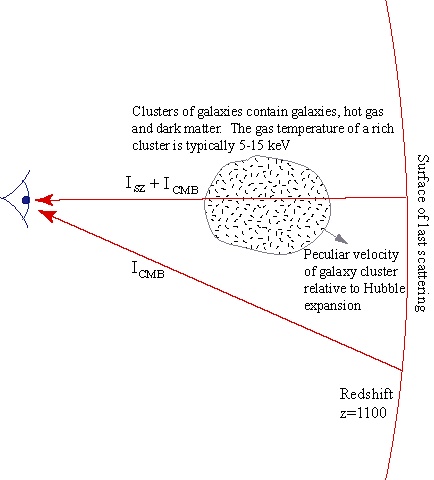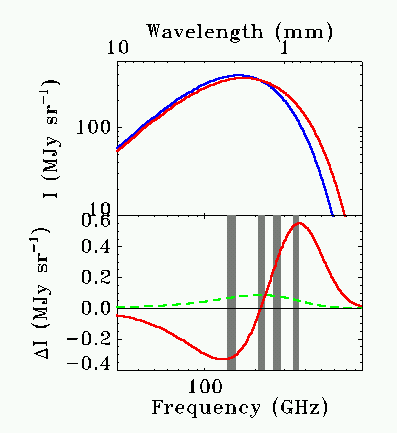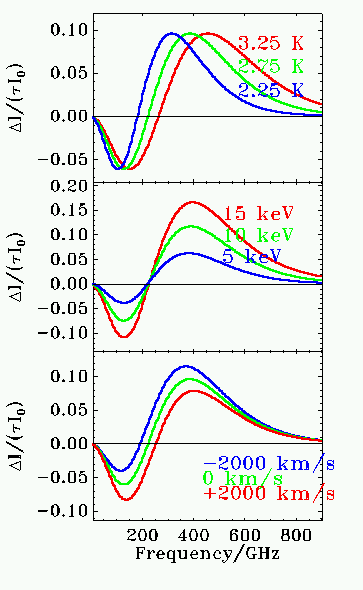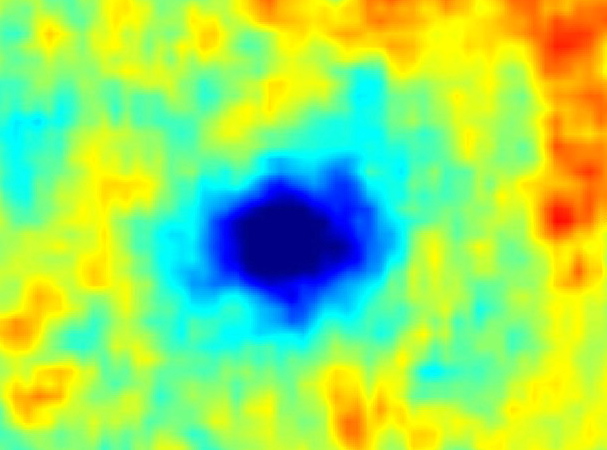The Cosmic Microwave Background radiation is a relic of the early universe, emitted about 400,000 years after the Big Bang, at a time when the universe was much hotter and denser. The CMB spectrum becomes distorted when CMB photons are scattered by extremely hot gas and this distortion is called the SZ effect. Most of the hot gas in the universe is contained in the potential wells of galaxy clusters, and this gas can be clearly seen by its X-ray emission. By measuring the SZ effect in the direction of a galaxy cluster (see Figure 1) one can infer physical properties of the cluster and other cosmological interesting parameters.

Figure 1: Cartoon drawing of the SZ effect.
The SZ effect can be broken into two components, the thermal and kinematic SZ effects. The thermal SZ effect is due to the random thermal motions of the scattering electrons. The kinematic SZ effect is due to the bulk velocity of the cluster relative to the rest frame of the CMB, this velocity is defined as the "peculiar velocity". In typical galaxy clusters at most frequencies, the thermal SZ effect is the brighter of the two and has the unique property that it appears as a decrement in intensity below 221 GHz and an increment above (see Figure 2). By measuring the spectrum of the SZ effect, these two components can be separated making it possible to
- Measure the local temperature of the CMB
- Measure the temperature of the gas
- Measure the peculiar velocity of a galaxy cluster
See Figure 3 for the spectral dependence of the SZ effect on these three parameters. Some of the science achievable from measurements of the SZ effect are as follows:
-
Modern cosmology has very definite predictions for the temperature evolution of the CMB. Currently, only very weak constraints exist on the temperature evolution of the CMB. By measuring the temperature of the CMB from the SZ effect towards many galaxy clusters, the temperature evolution of the CMB would be measured.
-
Clusters of galaxies represent the largest virialized objects in the universe. By measuring the electron temperature for a range of galaxy clusters with different masses and ages, we can test our theories of structure formation and evolution of galaxy clusters. This then can constrain a host of cosmological parameters, including the matter density of the universe.
-
Clusters of galaxies are can be thought of as test masses which are sensitive to the gravitational potential of the universe on its largest scale. By measuring the peculiar velocities of many galaxy clusters we can map the gravitational potential of the universe, which would allow a constraint on the matter density of the universe using completely different physics than other methods.
|

Figure 2: Top Panel - The spectrum of the CMB, before (blue) and after (red) being scattered by the hot gas
in a cluster. Bottom Panel - the difference spectrum, defined as the intensity change to the CMB caused by the SZ effect. The red curve is the thermal SZ effect, and the dashed green curve is the kinematic SZ effect. The gray regions show the 4 frequency bands in which SuZIE observes.

Figure 3: Top Panel - The difference spectrum for three different thermodynamic temperatures of the CMB. Middle Panel - The difference spectrum for three different cluster electron temperatures. Bottom Panel - The difference spectrum for three different cluster peculiar velocities.
|

